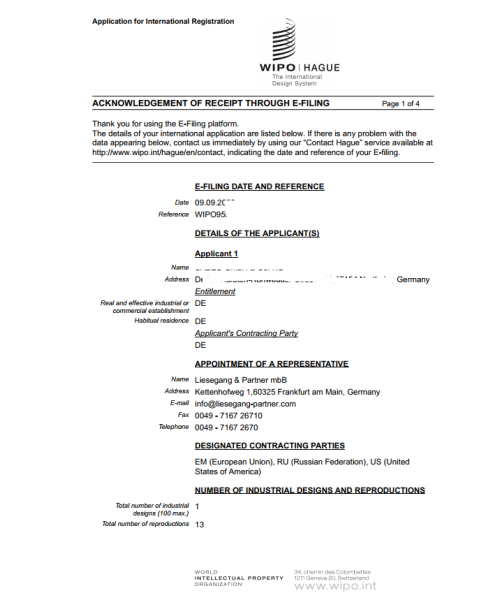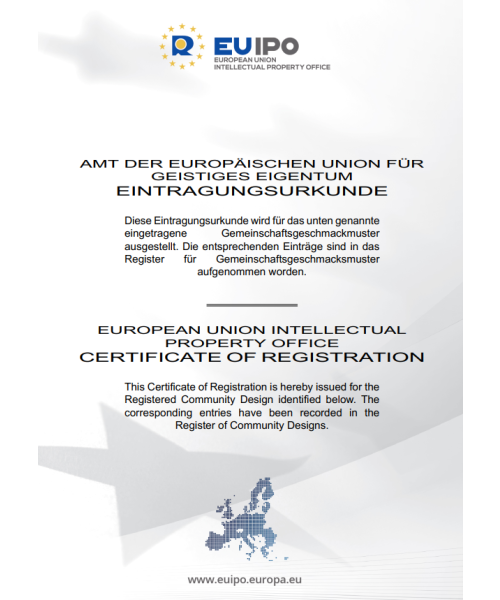International Design Registration: Protecting Your Designs Worldwide
The protection of design rights is no longer confined to the home country in today's globalized economy. Companies that operate internationally or wish to expand must ensure that their creative works are protected beyond their national borders. This requires careful planning and a thorough understanding of international design registration. In this article, you will learn how to protect your designs worldwide, the necessary steps, and the benefits of international design registration.
1. Importance of International Design Protection
1.1 Protection Against Imitation and Counterfeiting
With globalization, markets have become international, leading to an increase in product counterfeiting. Companies that do not protect their designs internationally risk having their creative works copied and distributed in other countries without being able to take legal action. International design protection offers effective protection against such imitations and ensures the exclusive use of your own designs.
1.2 Strengthening Market Position
An internationally protected design significantly strengthens a company's market position. It allows your products to be distributed in various markets while ensuring that competitors do not benefit from your creativity. This builds trust with business partners and customers and supports the development of a strong global brand.
1.3 Economic Benefits
Protecting designs on an international level can also bring economic benefits. Protected designs can be licensed or sold, creating additional revenue streams. Additionally, a comprehensive design protection portfolio increases the company's value, attracting interest from investors and potential buyers.
2. International Systems for Design Registration
2.1 Hague Agreement Concerning the International Registration of Industrial Designs
The Hague Agreement offers a simple way to protect designs in multiple countries simultaneously. It allows for the filing of a single application with the International Bureau of the World Intellectual Property Organization (WIPO), which then takes effect in the designated member countries.
2.1.1 Advantages of the Hague Agreement
- Simplified Application Process: A single application is sufficient to obtain protection in multiple countries.
- Cost Savings: Reduced administrative effort and fees make the process more cost-effective than individual national applications.
- Flexibility: The application can be extended later to include additional countries.
2.1.2 Requirements and Procedure
To apply for international design registration under the Hague Agreement, the applicant must be a national of a member state, have their domicile, or have a real and effective industrial or commercial establishment in a member state. The application must be submitted in one of the working languages of the Hague Agreement (English, French, or Spanish) and include the required information and images of the design.
2.2 Community Design of the European Union
The Community Design provides protection for designs in all EU member states. It can be applied for as either a registered Community design (RCD) or an unregistered Community design (UCD).
2.2.1 Registered Community Design (RCD)
The RCD offers comprehensive protection for up to 25 years. It must be registered with the European Union Intellectual Property Office (EUIPO).
- Scope: Protection in all current and future EU member states.
- Duration: Initial protection for five years, renewable in five-year periods up to a total of 25 years.
- Requirements: The design must be new and have individual character.
2.2.2 Unregistered Community Design (UCD)
The UCD offers limited protection for three years from the date it is first made available to the public within the EU. It protects against imitation but does not require formal registration.
2.3 National and Regional Design Applications
In addition to international and European systems, designs can also be registered directly in individual countries or regions. This may be necessary if protection is needed in countries that are not part of international agreements.
2.3.1 Advantages of National Applications
- Targeted Protection: Specific protection in countries of particular interest.
- Customizability: Ability to tailor the application to national specifics and requirements.
2.3.2 Disadvantages of National Applications
- Complexity and Cost: Significant administrative effort and higher costs compared to international systems.
- Administration: Required administration and monitoring in each individual country.
3. Steps to International Design Registration
3.1 Preparation and Research
3.1.1 Checking Protectability
Before applying for international design registration, ensure that your design is genuinely new and has individual character. Thorough research in existing design databases is essential to confirm that your design meets legal requirements.
3.1.2 Selecting Target Countries
Determine in which countries or regions design protection is necessary. Consider your current and future business activities, potential markets, and competitive situations.
3.2 Preparing Application Documents
3.2.1 Images and Descriptions
Ensure that your application documents include clear and complete images of your design. The quality of the images is crucial for the scope of protection. Supplement these with precise descriptions if required.
3.2.2 Classification
Classify your design under the appropriate class of the Locarno Classification. This international classification helps systematically categorize and facilitate the search and protection process.
3.3 Submitting the Application
3.3.1 Choosing the Application System
Depending on the target countries, choose the appropriate application system. Ensure that you are familiar with the respective requirements and procedures. Ensure that you are familiar with the respective requirements and procedures.
3.3.2 Fees and Payments
Pay the required application fees on time. Note that fees can vary depending on the number of target countries and the scope of protection.
3.4 Follow-up and Management
3.4.1 Monitoring Applications
Regularly monitor the status of your applications. Ensure that all deadlines are met and respond promptly to any inquiries or requirements from the respective authorities.
3.4.2 Renewals and Maintenance
Remember to maintain the protection of your designs through timely renewal applications and fees. Renewals are typically required at certain intervals, such as every five years.
4. Challenges and Solutions
4.1 Different Legal Requirements
4.1.1 Adapting to National Laws
The requirements and procedures for design registration can vary from country to country. It is important to familiarize yourself with the specific legal requirements in each target country and adapt your applications accordingly.
4.1.2 Support from Professionals
Collaboration with patent attorneys and design protection experts familiar with the respective national laws is crucial. These professionals can assist with preparing and submitting applications and addressing legal challenges.
4.2 Costs and Budget Planning
4.2.1 Estimating Total Costs
The costs of international design registration can be substantial. These include application fees, attorney fees, translation costs, and renewal fees. Careful budget planning is essential.
4.2.2 Cost Optimization
Use cost-efficient strategies such as applying through international systems (e.g., Hague Agreement) and bundling applications. Selecting the most important target countries can also help reduce costs.
4.3 Management and Monitoring
4.3.1 Managing Design Portfolios
Effective management of the design portfolio is crucial for long-term protection. Use appropriate software solutions and tools to manage and monitor your design applications and registrations.
4.3.2 Proactive Monitoring
Establish a system for proactive market monitoring to detect potential infringements early and take appropriate action. This includes monitoring new applications by competitors.
5. Benefits of International Design Registration
5.1 Expanding Market Presence
Comprehensive international design protection enables companies to expand their market presence and explore new markets. This creates the foundation for global growth and strengthens competitiveness.
5.2 Protecting Investments
International design protection allows companies to protect their investments in creative works and innovations. This ensures not only exclusivity but also the profitability of invested resources.
5.3 Strengthening the Brand
Strong international design protection contributes to brand strengthening. Protected designs increase the recognizability and uniqueness of products, enhancing customer trust and brand loyalty.
5.4 Competitive Advantage
Companies with comprehensive design protection enjoy a significant competitive advantage. They can exclusively offer their products and stand out from the competition. This supports positioning as an innovative and reliable company.
6. Success Stories and Case Studies
6.1 Success Story 1: Apple Inc.
Apple Inc. is a prime example of a company benefiting from strong international design protection. With numerous protected designs worldwide, Apple has successfully prevented imitations and built a strong brand identity. This has significantly contributed to its global success and market leadership.
6.2 Success Story 2: Dyson
The British company Dyson has also benefited from extensive design protection. By protecting its innovative designs, Dyson has successfully introduced its products to international markets and established itself as a premium brand in household appliances.
6.3 Case Study: A Medium-Sized Company
A medium-sized German company specializing in innovative furniture designs expanded its market presence in Europe and Asia through international design registration. Protection against imitation and the ability to license designs significantly contributed to the company's growth.
Conclusion
International design registration offers companies numerous opportunities to protect their creative works worldwide and strengthen their market position. Through careful planning, utilizing suitable application systems, and collaborating with professionals, companies can fully leverage the benefits of international design protection. Comprehensive protection not only secures investments and promotes innovation but also opens new business opportunities and enhances global competitiveness. Take advantage of international design registration to protect your creative works and elevate your company to the next level.
Consultation for Design Registration
Do you want to ensure that your design registration process is successful? Our experienced team offers comprehensive advice and customized solutions. Learn more about our services and how we can help you protect your designs effectively.
Our Services Include:
- Design Registration Consultation: Tailored strategies for the successful filing of your design.
- Research Services: Verification of the novelty and uniqueness of your design.
- Management and Renewal: Assistance with managing and renewing your design protection.
Visit our Design Registration Consultation page for detailed information and tailored consultation packages.
Contact Us
Do you have questions or want to schedule a consultation? Use our Contact Form to reach us. We are here to help and support you at every step of your design registration process.

Attorney at law and certified specialist lawyer for intellectual proterty law

Attorney at law and certified specialist lawyer for intellectual proterty law and information technology law
Do you need professional assistance with registering your designs? Our experienced team offers comprehensive advice and customized solutions. Visit our
page for detailed information and tailored consultation packages.
Do you have questions or want to schedule a consultation? Use our
to reach us. We are here to help!



